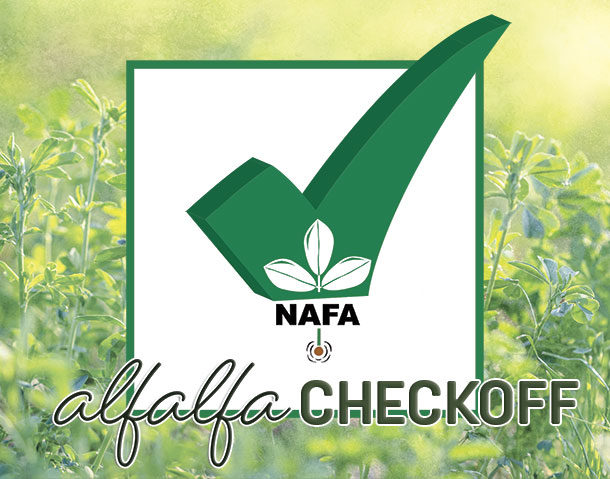As some of the targeted producers in the region have a negative view of alfalfa and its management challenges, many of these efforts have been under a pretext of demonstrating cutting and fertility management techniques.
Within the program, discussion about the benefits of alfalfa production and use are integrated. This results in participants realizing alfalfa has potential as a forage crop because of the combination of new varieties, better nutrient management techniques and marketing opportunities for the region.
Alfalfa requires high phosphorus (P) and potassium (K) soil fertility and has a high demand for these nutrients. Alfalfa removes large amounts of nitrogen (N) and K from the field when harvested as hay and also has the ability to draw down nitrate levels within its root zone, thus decreasing nutrient runoff and leaching potential. Manure, particularly poultry litter, is high in P and K and micronutrients such as boron. Proper applications of poultry litter to alfalfa can provide sufficient quantities of required nutrients without overloading the soil profile.
Poultry production was the top agricultural commodity in Mississippi for 2016, grossing nearly $2.3 billion in sales and ranking fifth in the nation. Poultry has been the leading commodity in Mississippi for over 20 straight years. Poultry litter, a mixture of manure, feathers and bedding material, is a valuable source of plant nutrients and organic matter of great interest to many livestock and row-crop farm managers across Mississippi and remains the most sustainable option for disposal.
For forages, linking dry matter (DM)production with litter utilization can be a difficult yet effective approach for addressing both the problems associated with manure disposal and reducing impact on the environment. Oftentimes, poultry litter is the most economical and most available source of fertilizer in Mississippi.
As alfalfa acreage across Mississippi and the Deep South increases, information regarding fertility management in this crop is crucial in helping new farmers produce an economically sustainable forage. This project seeks to bridge this knowledge gap by evaluating the impacts of poultry litter on alfalfa production in Mississippi.
Field trials were established in 2017 at Newton and Starkville, Mississippi. These trials compared poultry litter with traditional commercial fertilizer across three varieties. Fertilizer treatments included two rates of poultry litter (1 and 2 ton per acre) and two commercial treatments (one used the same amount of N, P and K as the litter analysis [positive control], and the other was the same P and K, but no N was applied [negative control]). Treatments were applied after every two harvests. DM yield, along with stand persistence (crown counts) and nutritive value (NIRS) were collected.
Due to heavy rains and poor drainage, combined with heavy weed infestations, the Starkville site was abandoned in the spring of 2018 with no harvests conducted. For Newton, excellent establishment and weed control was accomplished. Six harvests were conducted in 2018. Bulldog 505 generated the greatest DM in 2018 (Table 1). No differences were observed between fertilizer treatments; however, as the season progressed, plots that received the 2-ton-per-acre rate of poultry litter had greater stand persistence.
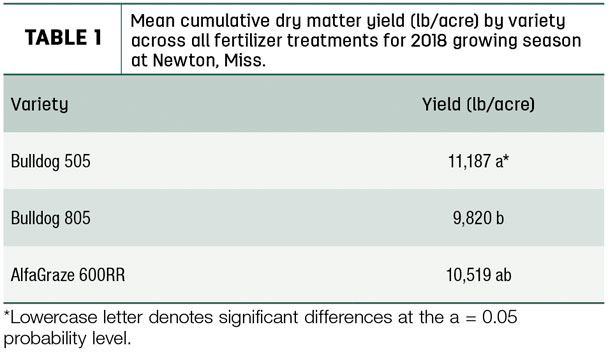
This persistence will more than likely translate to greater yields in 2019. In terms of nutritive value, some differences were observed between variety and treatment for each parameter. Crude protein was only affected by harvest and ranged from 20.8 to 26.5 percent. Both total digestible nutrients (TDN) and relative forage value (RFV) differed by variety (Table 2 and Table 3). Like DM yield, Bulldog 505 generally outperformed the other two varieties in quality attributes as well.
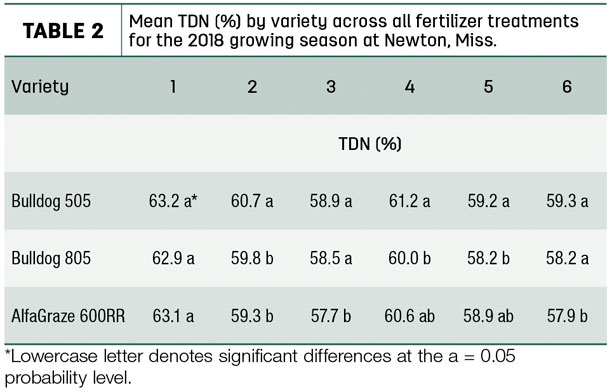
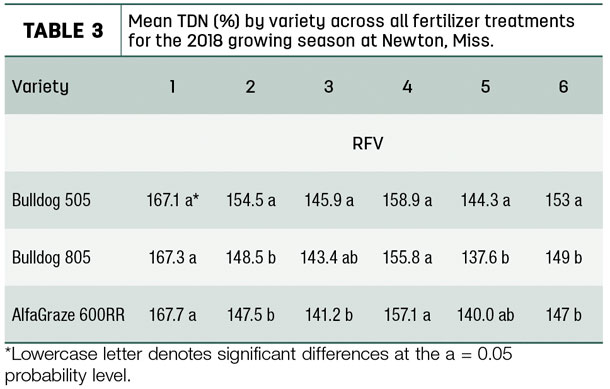
Along with agronomic productivity, an economic comparison was also made (Table 4). In the South, a majority of the high-quality hay produced is bermudagrass, mostly hybrid varieties bred for improved quality or yield attributes.
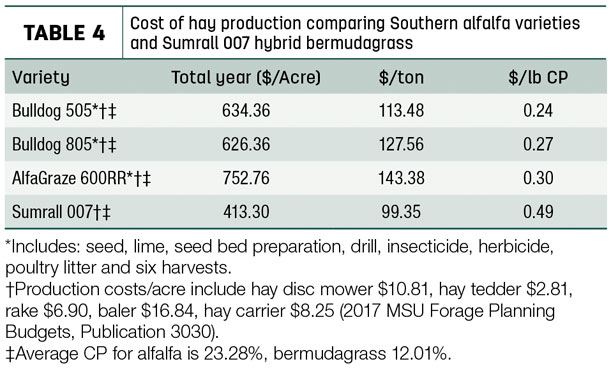
In Newton, Sumrall 007 is grown and was used as comparison to the alfalfa varieties tested. One of the major concerns of producers considering growing alfalfa for hay production is the initial cost of seed.
In our economic analysis, we account for seed costs in the first year of production instead of prorating it out over the life of the stand. This is done, in most part, to prepare a contingency plan in case the stand does not persist beyond the first year of production. (Most trials conducted in Mississippi with proper management last up to three years.)
Our costs were calculated using the 2017 Mississippi State University Forage Planning Budget (Publication 3030), which accounted for all direct and fixed costs. Cost per acre and cost per ton were substantially higher for the alfalfa varieties when compared to bermudagrass. However, Bulldog 505 had the lowest cost per pound of protein (24 cents).
This was less than half the cost of the hybrid bermudagrass (49 cents) that was harvested four times in the same year (8,326 pounds DM per acre per year). Mean crude protein concentration for the bermudagrass was 12.01 percent compared to 23.28 percent for all alfalfa varieties tested. The increase in quality led to a cheaper end product.
Results from the first year of this trial were very promising, particularly for the implementation of poultry litter into alfalfa production. More substantial evidence supporting the use of poultry litter is anticipated for 2019. Also, nutrient removal will be assessed upon the conclusion of this field trial.
Soil sampling has been taking place throughout the study in hopes of quantifying nutrient concentrations – of particular concern is P. Overall, this study has generated quite a bit of interest in alfalfa production. The alfalfa checkoff program has made it possible for public institutions to research and develop best management practices for Southern hay producers. ![]()
Brett Rushing is the lead researcher from Mississippi State University on this project and is collaborating with Rocky Lemus, also at MSU.

-
J. Brett Rushing
- Coastal Plain Branch Experiment Station
- Newton, Mississippi
- Email J. Brett Rushing
